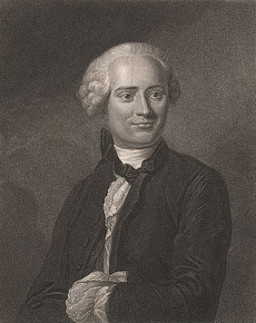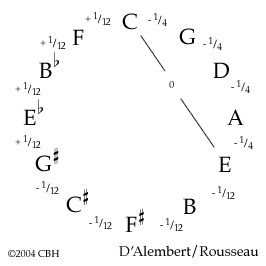Technical Library
TEMPERAMENTS XVI: D’Alembert/Rousseau
Entire Contents Copyright © 2020 CBHTechnical LibraryTEMPERAMENTS XVI: D’Alembert/Rousseau Entire Contents Copyright © 2020 CBH |
 WIKIMEDIA COMMONS / PUBLIC DOMAIN |
| Jean-Baptiste le Rond d’Alembert (1717–1783) |

There is much interest now in a variety of French temperaments known individually
as tempérament ordinaire. In this group there are in
fact a number of extraordinary and useful schemes, most of which favor the sharp
keys at the expense of the flats.
In his 1752 treatise Élémens de musique, theorique et pratique, suivant les principes de Monsieur Rameau, Jean-Baptiste le Rond d’Alembert (1717–1783) was the first to use the phrase tempérament ordinaire to describe the usual method in vogue for tuning both organ and harpsichord. Jean-Jacques Rousseau (1712–1778) reiterated d’Alembert’s method in his 1767 Dictionnaire de Musique, so let’s call this temperament D’Alembert/Rousseau 1752/67.
Note from the diagram that it is characterized by the C–E pure third with its enclosed four quarter-comma fifths, same as Kirnberger III. The other fifths, however, are not pure. The fourth fifths on the sharp side of E are slightly narrow, improving the sharp keys by bringing the Major thirds below each of B, F♯, C♯ and G♯ closer to their tonics. The fifths on the flat side of C are again not pure, but slightly wide, making the flat keys immediately rougher than the sharps, and the Major thirds above F, B♭ and E♭ progressively harsher. (Note that for convenience I have shown these wide fifths as + 1/12 comma in the diagram: Mathematicians will tell me I’m wrong. In fact, theoretically they are almost but not quite as wide as an Equal Temperament fifth is narrow.)
Christophe Rousset chose this temperament for his two sold-out solo recitals in Tokyo and Osaka in June 2011 in aid of the East Japan Earthquake Benefit: I tuned Marc Ducornet’s copy of the Colmar Ruckers for Christophe’s program of Louis and François Couperin. We also used D’Alembert/Rousseau for Pinchgut Opera’s 2012 production of Rameau’s Castor & Pollux and again in December 2014 for Gluck’s Iphigénie en Tauride.
You can conveniently alter your Kirnberger III base to this temperament as follows:
1. Retune the four perfect fifths on the sharp side of E so that each fifth is slightly narrow—in fact, a twelfth of a comma, the same amount as an equal tempered fifth. To make sure you are indeed working on the correct side of each fifth and narrowing them instead of widening, tune the interval pure first of all and then squeeze it. Stop at your G♯.
2. Retune the three perfect fifths on the flat side of C remaining from Kirnberger III so that each of these fifths
is slightly wide the same small amount. Don’t move your G♯!
To ensure you are indeed expanding the fifths, tune the fifth pure first of all
and then widen it.
To tune D’Alembert/Rousseau 1752/67 from scratch, follow these steps:
1. Tune c'' to your pitch source, and tune middle c' an absolute pure octave below it.
2. Tune a pure c'–e' third, and divide it into four quarter-comma narrow fifths, making g–d', a–e', c'–g' and d'–a' sound equally rough.
3. Tune the four perfect fifths on the sharp side of E so that each fifth is slightly narrow, stopping at your G♯. Tune each fifth pure first of all, then narrow it.
4. Tune the three perfect fifths on the flat side of C so that each of these fifths is slightly wide the same small amount. Don’t move your G♯! Tune each fifth pure first of all and then widen it.
Further discussion
Anonymous [Kayano, Moxzan] Dodecagon — Chi-s akt temo Tokyo 2012, p32
Asselin, Pierre-Yves Musique et Tempérament Éditions Costallat, Paris 1985, p119
Klop, G C Harpsichord Tuning Werkplaats voor Clavecimbelbouw, Garderen 1974, p24 (“18th cent. Italian”)
Padgham, Charles The Well-Tempered Organ Positive Press, Oxford 1986, p82 (“18th century Italian”)
| Pitch nomenclature | |
| Harpsichord Tuning Process | |
| Tuning Bibliography | |
| Technical Library overview | |
| Harpsichords Australia Home Page |